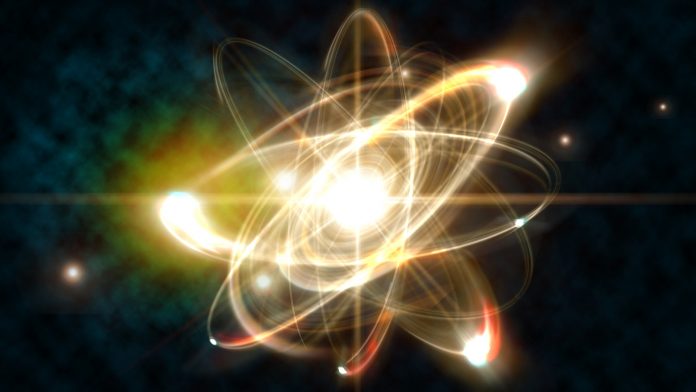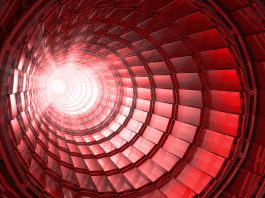Professor Gabriel Martínez-Pinedo from GSI Helmholtzzentrum für Schwerionenforschung discusses the r-process and its role in the formation of heavy elements.
Around 98% of all the observable matter in the Universe consists of hydrogen and helium. These elements were created in the hot, early phase of the Universe, about a minute after the Big Bang. Heavier elements including carbon, oxygen and iron are produced by fusion processes in stars and finally ejected to the interstellar medium by stellar winds and supernova explosions.
The production of heavier nuclei requires free neutrons, as processes involving charged particles are suppressed due to the increase in coulomb barrier with atomic number. Neutron-captures lead to the production of new isotopes of the same element that are unstable to beta-decay. After the beta-decay, a new element is produced with a higher atomic number. Following this sequence of neutron captures and beta-decays, heavy elements are synthesised. Depending on the relative magnitude of the time scales for successive neutron captures and beta-decay, two possibilities emerge that depend on the neutron density of the astrophysical environment. At low neutron densities, the beta-decay time scale is shorter than the neutron capture time scale and we deal with the ‘slow’ or ‘s’ process that is responsible for the production of half of the elements between iron and lead. For high neutron densities, the timescale for neutron captures becomes shorter than the one for beta-decay. The resulting sequence of reactions constitutes the ‘rapid’ or ‘r’ process (see figure 1).
The s-process operates in stars of low and intermediate mass (less than eight solar masses) during their asymptotic giant branch phase. This is confirmed by the observation of 98Tc in the surface of these stars. Its half-life, 4.2 million years, is too short compared with the lifetime of the star where it is observed, and so its must be produced in situ.
Compared with the s-process, the situation for the r-process is rather different. Research during the 20th century has developed a complete picture of the nuclear processes responsible for the production of energy in stars and the nucleosynthesis of elements. However, the identification of one of the sites where the r-process operates has only been possible recently. Further research is still needed to determine the extent of r-process nuclei produced in the site and the frequency with which these events occur in the Galaxy.
Operation of the r-process and the role of nuclear physics
The r-process operates on a timescale of seconds, producing elements up to thorium and uranium. It involves neutron densities above 1020 cm−3 and temperatures of around 1 GK that lead to the production of very neutron-rich nuclei by a sequence of neutron-captures and beta-decays. Once the initial supply of neutrons is used, the material decays to stability, producing the final abundance distribution that can be compared with observations. The radioactive energy liberated during these decays can potentially lead to a bright electromagnetic transient similar to the decay of 56Ni to 56Co and finally 56Fe powering the light curve of a supernova. Models show that an r-process transient can be as bright as a thousand novae and hence the name ‘kilonova’.
The r-process remains the most complex nucleosynthesis process to model from the astrophysics as well as nuclear physics points of view. From the nuclear physics point of view, the r-process requires the properties of nuclei with extreme neutron excess far from the valley of stability. Most of these nuclei have not yet been produced in the laboratory and their properties (masses, neutron-capture rates, beta-decay half-lives, and fission rates) have to be computed theoretically. These three reactions (neutron-captures, beta-decays, and fission) are fundamental to describe r-process nucleosynthesis.
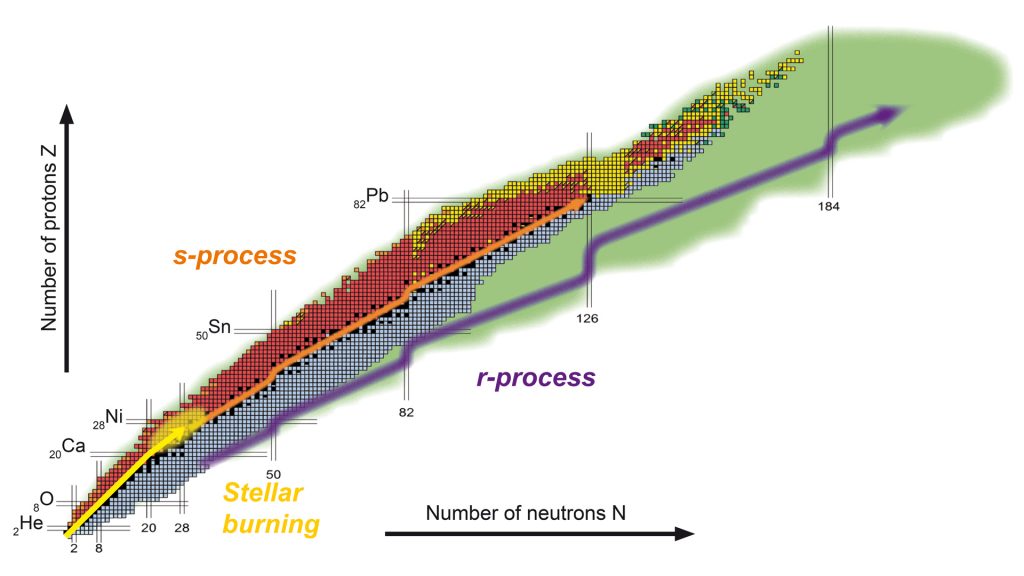
Nuclear masses
The masses of these exotic neutron-rich nuclei and their dependence on neutron excess that are particularly important for the r-process. The presence of magic neutron numbers at Nmag=50,82,126, and 184 results in small neutron separation energies for nuclei with neutron number Nmag+1. Hence, the neutron capture rates become very small at the magic neutron numbers, requiring a sequence of several neutron-captures and beta-decays for the r-process to proceed to heavier nuclei. The r-process path moves closer to the line of beta-stability, experiencing longer beta-decay half-lives than those of ‘regular’ r-process nuclei. These long beta-decay half-lives result in an accumulation of material at the magic numbers. It produces peaks corresponding to maxima in the r-process abundance pattern at A~90,130, and 195.
Fission
Fission reactions during the r process involve several competing reaction channels, including neutron induced fission, beta-delayed fission, spontaneous fission, and gamma-induced fission. During the last phase of the r-process, alpha decays compete with fission in the region of translead nuclei. This competition determines the abundances of long-lived actinides at timescales of days and the final abundances of lead, uranium, and thorium. Fission is also an important source of neutrons during the last phases of the r-process. Those neutrons, together with the fission yields, shape the final abundance distribution and lead to a robust abundance distribution that is basically independent of the astrophysical conditions as suggested by astronomical observations.
Beta-decay
The role of beta-decay in the r-process is twofold. First, by changing a neutron into a proton determines how fast the nucleosynthesis flow moves from one isotopic chain to the next, i.e. the speed at which heavy nuclei are produced starting from the seed nuclei. Secondly, beta-decay produces neutrons via beta-delayed neutron emission that play an important role in determining the final r-process abundances.
Radioactive beam facilities have been fundamental to measuring the masses and beta-decay rates for r-process nuclei in key regions around the magic numbers N=50 and 82. These data, combined with theoretical advances, has led to the development of fully microscopic models for the description of masses and beta-decays of r-process nuclei, leading to improved predictions of r-process yields.
The future FAIR facility will allow, for the first time, experimental access to heavy r-process nuclei around magic number N=126 removing one of the largest uncertainties affecting prediction of r-process yields.
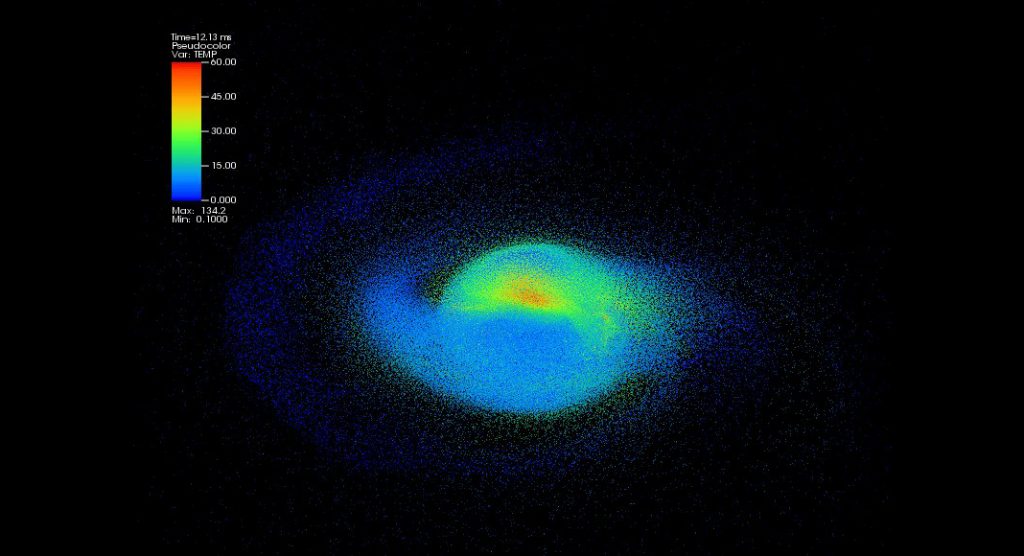
Observational constraints in the r-process
Our present understanding of the operation of the r-process in the Galaxy is based on observations of isotopic and elemental abundances in the Solar system and stars of different ages. These stars are formed from clouds of material that were polluted by r-process nucleosynthesis events that occurred much before their formation. Observations of abundances in our Solar System provide unique information about the proportions at which the different isotopes of a given element are produced by nucleosynthesis processes.
Stellar observations provide information about the abundances of elements at different locations in the Galaxy and at different times of galactic evolution. Astronomers use the metallicity of a star, i.e. the relative abundance of iron to hydrogen, as a proxy for its age. Particularly important are observations at low metallicities, as they may allow us to observe the products of individual nucleosynthesis events. These observations show that the r-process already operates at the lowest metallicities we have been able to observe, corresponding to a relative iron to hydrogen abundance 10-4 times the one of the Sun. They show that, independently of the location in the Galaxy, the relative abundances of elements above Z∼50 are always very similar, indicating that there is a mechanism that leads to such a robust abundance pattern. As discussed above, fission may provide such a mechanism.
Stellar observations show that the r-process operates on events that eject substantial amounts of r-process material and occur with a frequency much smaller than core-collapse supernova that are the main contributors to the production of Iron at low metallicities. As a consequence, one is left with basically two possible astrophysical sites in which the r-process can operate1:
- A rare class of supernova explosions that involve rotation and high magnetic fields; and
- Compact binary mergers, i.e. the coalescence of double neutron star or neutron star-black hole binaries.
In 2017, we were able to observe, for the first time, the in-situ operation of the r-process by measuring the kilonova light produced by the radioactive decay of freshly synthesised r-process material following the merger of two neutron stars. Similar to the observation of technetium in asymptotic giant branch stars, this observation provided the smoking gun that identifies neutron star mergers as the dominant r-process site in the late phases of Galactic evolution.
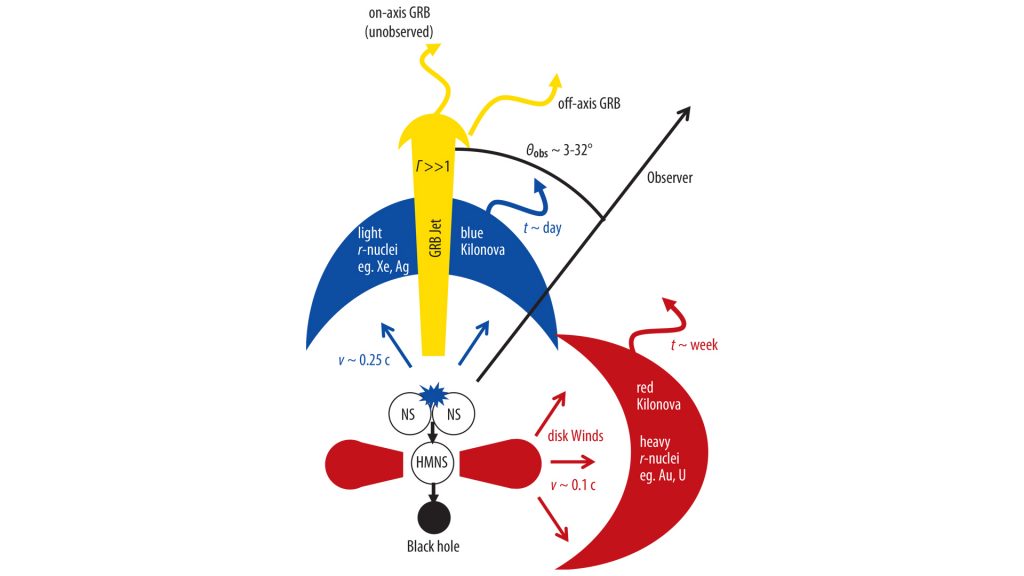
The r-process in compact binary mergers
The first direct detection of gravitational waves originating from the merger of two neutron stars, denoted GW170817, took place on 17 August, 2017 by the advanced LIGO and Virgo collaborations. Around 1.7 seconds after the end of the gravitational wave signal, the Fermi and Integral satellites detected a short gamma-ray burst with a sky-localisation consistent with the one of LIGO/Virgo. 11 hours later, the source was identified in the Galaxy NGC 4993 at ∼40 Mpc thanks to the observation of a bright optical transient.
The emission of gravitational waves occurs during several phases of the neutron star merger. The signal detected by the LIGO and Virgo detectors corresponds to the inspiral phase during which the two neutron stars approach each other and finally merge. During their approach, tidal gravitational forces deform the neutron stars, leaving an imprint in the gravitational wave signal which allows to determine the so-called ‘tidal deformability’ of the neutron stars. Its measurement by the LIGO and Virgo collaborations has been used to provide constraints on the high density equation of state.
Further information about the equation of state can be obtained from the so-far undetected post-merger gravitational signal. As the sensitivity of the gravitational wave detectors improves, it will become possible to measure this signal and obtain information of the equation of state at even higher densities and may even contain signatures of a phase transition from hadronic to quark matter. In this sense, gravitational wave observations are complementary to heavy ion collision experiments, e.g. the HADES experiment at GSI and the CBM experiment at the future FAIR facility, that aim to map the QCD phase diagram. The post-merger gravitational signal will also determine the nature of the central remnant: a neutron star or a black hole.
For the r-process to operate in neutron star mergers, the ejected matter needs to achieve conditions in which the production of neutrons relative to nuclei, the so called ‘neutron-to-seed ratio’, is large enough to give rise to a successful r process. Astrophysical environments with densities (larger than 1011 g cm−3 and temperatures (around 1 GK consist of matter composed of neutron-rich nuclei and large amounts of free neutrons because of electron captures driven by the high Fermi energy of the degenerate electrons. In mergers, these conditions are achieved in the outer regions of neutron stars and in accretion disks that surround the central remnant. Several mechanisms contribute to the ejection of this material. During the coalescence phase matter is ejected dynamically due to angular-momentum conservation on timescales of milliseconds (see Fig. 2). Additional material is ejected on longer timescales of several hundreds of milliseconds from the accretion disk that surrounds the central remnant.
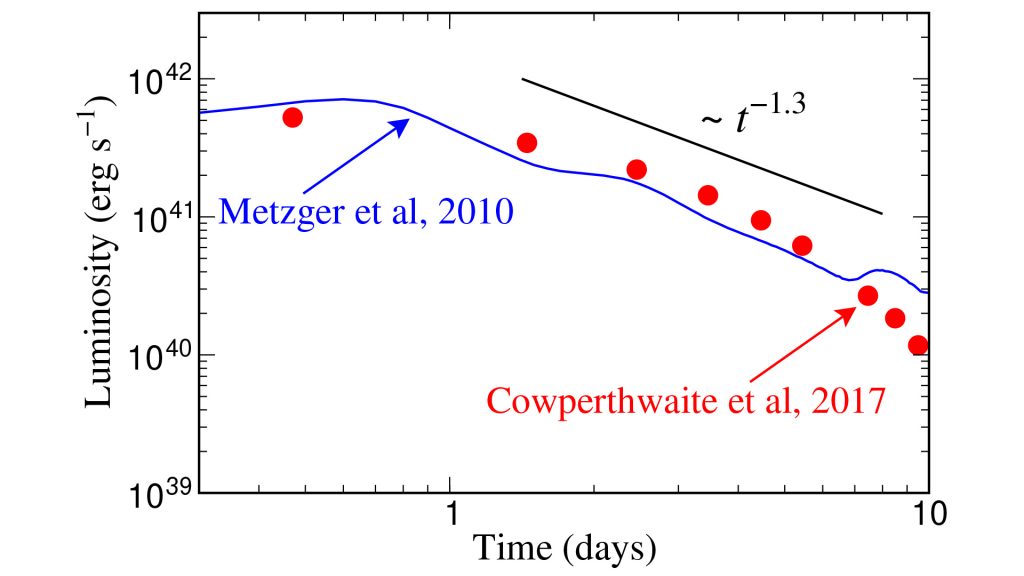
Initially, when the material is ejected it is very hot and consists of neutrons and protons. Weak interaction processes, including electron and positron captures and electron neutrino and antineutrino absorptions, convert neutrons into protons and vice versa. These processes determine the ratio between neutrons and protons and consequently the heaviest nuclei the r-process can produce. Simulations show that if the central remnant is a hypermassive neutron star (HMS), the fluxes of electron neutrinos and antineutrinos are very large and the ejected material, particularly in the polar regions, is moderately neutron rich. Therefore, the r-process synthesises only medium mass nuclei and no lanthanides are produced. Hence, the nucleosynthesis is sensitive to the lifetime of the hypermassive neutron star before collapsing to a black hole. Once a black hole is formed, the neutrino fluxes of neutrinos reduce and the ejected material is neutron-rich enough for the r-process to synthesise elements up to uranium and thorium. Fig. 3 shows the distribution of ejecta and the evolution of the merging system as inferred from the observations of the kilonova associated to GW170817.
The radioactive decay of freshly synthesised r-process material produces energy and leads to an electromagnetic transient similar to the bright supernova produced by the decay of 56Ni. However, in this case we deal with a broad distribution of nuclei, all of them decaying simultaneously. As a consequence, the energy produced follows a power law instead of an exponential law. The different decay products, including photons, electrons, alpha particles, and nuclei produced by fission, deposit their energy in the plasma with different efficiencies, which depend on their nature and the local state of matter. The latter is also a function of properties such as the total amount of ejected material, its expansion velocity, and the presence of magnetic fields, allowing us to determine these properties from observations.
The radioactive energy is finally emitted following a quasi-thermal spectrum that covers wavelengths from the ultraviolet to the near infrared. The timescale at which the emission takes place, and its colour, depend sensitively on the opacity of the material that is dominated by bound-bound atomic transitions. Light curve models are particular sensitive to the presence of lanthanides as they determine the opacity of the ejecta at visual wavelengths. The structure of these elements is dominated by f-shell valence electrons and leads to a large density of bound-bound transitions and high opacity values. Lanthanide-free ejecta become transparent on timescales of days when the material is still relatively hot and the emission occurs mainly in the blue. A few percent content of lanthanides in the ejecta is enough to increase the opacity such as the emission occurs at timescales of a week when the material is colder and hence emits in the near infrared.
The time and colour evolution of the bolometric luminosity of the kilonova associated to GW170817 (see Fig. 4) has confirmed the predictions discussed above and originates from the radioactive decay of freshly synthesised r-process elements. Visual (‘blue’) emission was detected early on, which then faded and was supplanted after a few days by a second distinct emission component at near-infrared (‘red’) wavelengths, thus indicating the presence of at least two separate ejecta components. The blue kilonova component implies material from the fastest polar outer layers of the ejecta that has been exposed to a high level of neutrino irradiation (see Fig. 3). The red kilonova component requires the presence of lanthanides in the ejecta originating from the accretion disk. The transition of the emission colours to the near-infrared points to a collapse of the HMNS to a black hole. The red emission together with the identification of strontium lines in the kilonova spectra have demonstrated that heavy elements are synthesised by the r-process in neutron star mergers.
Despite the wealth of information provided by observations of the kilonova associated to GW170817, further observations are necessary to obtain direct spectroscopic evidence for the production of elements heavier than lanthanides. Furthermore, it is important to determine if neutron star black hole mergers also produce a kilonova and its properties. Kilonova observations have opened new possibilities to determine the conditions at which the r-process operates, the dynamics and distribution of the ejected material, and the evolution of the central merger remnant. They provide complementary information to gravitational waves emphasising the enormous benefits of multi-messenger astronomy. By combining these observations with high quality experimental data, state-of-the-art nuclear models and sophisticated astrophysical modelling, a new era in our understanding of r-process has begun.
Acknowledgements
Support from the Deutsche Forschungsgemeinschaft (DFG, German Research Foundation) – project-ID 279384907 – SFB 1245 ‘Nuclei: From Fundamental Interactions to Structure and Stars’ and the European Research Council (ERC) under the European Union’s Horizon 2020 research and innovation programme (ERC Advanced Grant KILONOVA No. 885281) is acknowledged.
References
- J. J. Cowan, C. Sneden, J. E. Lawler, A. Aprahamian, M. Wiescher, K. Langanke, G. Martínez-Pinedo, and F.-K. Thielemann, ‘Origin of the Heaviest Elements: The Rapid Neutron-Capture Process’, Rev. Mod. Phys. 93, 015002 (2021)
- B. D. Metzger, G. Martínez-Pinedo, S. Darbha, E. Quataert, A. Arcones, D. Kasen, R. Thomas, P. Nugent, I. V. Panov, and N. T. Zinner, ‘Electromagnetic Counterparts of Compact Object Mergers Powered by the Radioactive Decay of R-Process Nuclei’, Mon. Not. R. Astron. Soc. 406, 2650 (2010)
Please note, this article will also appear in the sixth edition of our quarterly publication.

